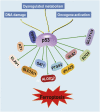The potential interplay between G-quadruplex and p53: their roles in regulation of ferroptosis in cancer
- PMID: 35959461
- PMCID: PMC9358135
- DOI: 10.3389/fmolb.2022.965924
The potential interplay between G-quadruplex and p53: their roles in regulation of ferroptosis in cancer
Abstract
Ferroptosis is a novel form of regulated cell death trigged by various biological processes, and p53 is involved in different ferroptosis regulations and functions as a crucial regulator. Both DNA and RNA can fold into G-quadruplex in GC-rich regions and increasing shreds of evidence demonstrate that G-quadruplexes have been associated with some important cellular events. Investigation of G-quadruplexes is thus vital to revealing their biological functions. Specific G-quadruplexes are investigated to discover new effective anticancer drugs. Multiple modulations have been discovered between the secondary structure G-quadruplex and p53, probably further influencing the ferroptosis in cancer. G-quadruplex binds to ferric iron-related structures directly and may affect the p53 pathways as well as ferroptosis in cancer. In addition, G-quadruplex also interacts with p53 indirectly, including iron-sulfur cluster metabolism, telomere homeostasis, lipid peroxidation, and glycolysis. In this review, we summarized the latent interplay between G-quadruplex and p53 which focused mainly on ferroptosis in cancer to provide the potential understanding and encourage future studies.
Keywords: G-quadruplex; biological activities; cancer; ferroptosis; p53.
Copyright © 2022 Zhang, Lu, Ma, Xing, Sun and Jia.
Conflict of interest statement
The authors declare that the research was conducted in the absence of any commercial or financial relationships that could be construed as a potential conflict of interest.
Figures
Similar articles
-
[The Detections, functions and regulations of G-quadruplex].Sheng Li Ke Xue Jin Zhan. 2014 Oct;45(5):364-71. Sheng Li Ke Xue Jin Zhan. 2014. PMID: 25764797 Chinese.
-
Ferroptosis and the bidirectional regulatory factor p53.Cell Death Discov. 2023 Jun 29;9(1):197. doi: 10.1038/s41420-023-01517-8. Cell Death Discov. 2023. PMID: 37386007 Free PMC article. Review.
-
p53 binds human telomeric G-quadruplex in vitro.Biochimie. 2016 Sep-Oct;128-129:83-91. doi: 10.1016/j.biochi.2016.07.004. Epub 2016 Jul 12. Biochimie. 2016. PMID: 27422117
-
Wild-type p53 binds to MYC promoter G-quadruplex.Biosci Rep. 2016 Oct 14;36(5):e00397. doi: 10.1042/BSR20160232. Print 2016 Oct. Biosci Rep. 2016. PMID: 27634752 Free PMC article.
-
The influencing factors and functions of DNA G-quadruplexes.Cell Biochem Funct. 2020 Jul;38(5):524-532. doi: 10.1002/cbf.3505. Epub 2020 Feb 13. Cell Biochem Funct. 2020. PMID: 32056246 Free PMC article. Review.
Cited by
-
Chromatin Immunoprecipitation Reveals p53 Binding to G-Quadruplex DNA Sequences in Myeloid Leukemia Cell Lines.ACS Bio Med Chem Au. 2025 Feb 12;5(2):283-298. doi: 10.1021/acsbiomedchemau.4c00124. eCollection 2025 Apr 16. ACS Bio Med Chem Au. 2025. PMID: 40255281 Free PMC article.
-
UXT at the crossroads of cell death, immunity and neurodegenerative diseases.Front Oncol. 2023 Apr 19;13:1179947. doi: 10.3389/fonc.2023.1179947. eCollection 2023. Front Oncol. 2023. PMID: 37152054 Free PMC article. Review.
-
The Therapeutic Potential of Targeting Ferroptosis in the Treatment of Mitochondrial Cardiomyopathies and Heart Failure.J Cardiovasc Pharmacol. 2024 Jan 1;83(1):23-32. doi: 10.1097/FJC.0000000000001496. J Cardiovasc Pharmacol. 2024. PMID: 37816193 Free PMC article.
-
Mitogen Activated Protein Kinase (MAPK) Activation, p53, and Autophagy Inhibition Characterize the Severe Acute Respiratory Syndrome Coronavirus 2 (SARS-CoV-2) Spike Protein Induced Neurotoxicity.Cureus. 2022 Dec 9;14(12):e32361. doi: 10.7759/cureus.32361. eCollection 2022 Dec. Cureus. 2022. PMID: 36514706 Free PMC article. Review.
-
Prediction and validation of circulating G-quadruplexes as a novel biomarker in colorectal cancer.J Gastrointest Oncol. 2024 Feb 29;15(1):286-298. doi: 10.21037/jgo-24-26. Epub 2024 Feb 28. J Gastrointest Oncol. 2024. PMID: 38482213 Free PMC article.
References
-
- Andorf C. M., Kopylov M., Dobbs D., Koch K. E., Stroupe M. E., Lawrence C. J., et al. (2014). G-quadruplex (G4) motifs in the maize (Zea mays L.) genome are enriched at specific Locations in Thousands of genes Coupled to energy status, hypoxia, low sugar, and Nutrient Deprivation. J. Genet. Genomics 41 (12), 627–647. 10.1016/j.jgg.2014.10.004 - DOI - PubMed
Publication types
LinkOut - more resources
Full Text Sources
Research Materials
Miscellaneous



